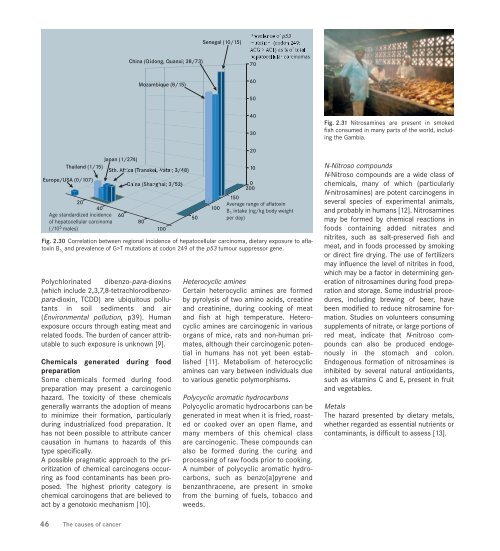world cancer report - iarc
world cancer report - iarc
world cancer report - iarc
You also want an ePaper? Increase the reach of your titles
YUMPU automatically turns print PDFs into web optimized ePapers that Google loves.
Fig. 2.30 Correlation between regional incidence of hepatocellular carcinoma, dietary exposure to aflatoxin<br />
B 1, and prevalence of G>T mutations at codon 249 of the p53 tumour suppressor gene.<br />
Polychlorinated dibenzo-para-dioxins<br />
(which include 2,3,7,8-tetrachlorodibenzopara-dioxin,<br />
TCDD) are ubiquitous pollutants<br />
in soil sediments and air<br />
(Environmental pollution, p39). Human<br />
exposure occurs through eating meat and<br />
related foods. The burden of <strong>cancer</strong> attributable<br />
to such exposure is unknown [9].<br />
Chemicals generated during food<br />
preparation<br />
Some chemicals formed during food<br />
preparation may present a carcinogenic<br />
hazard. The toxicity of these chemicals<br />
generally warrants the adoption of means<br />
to minimize their formation, particularly<br />
during industrialized food preparation. It<br />
has not been possible to attribute <strong>cancer</strong><br />
causation in humans to hazards of this<br />
type specifically.<br />
A possible pragmatic approach to the prioritization<br />
of chemical carcinogens occurring<br />
as food contaminants has been proposed.<br />
The highest priority category is<br />
chemical carcinogens that are believed to<br />
act by a genotoxic mechanism [10].<br />
46 The causes of <strong>cancer</strong><br />
p53<br />
Heterocyclic amines<br />
Certain heterocyclic amines are formed<br />
by pyrolysis of two amino acids, creatine<br />
and creatinine, during cooking of meat<br />
and fish at high temperature. Heterocyclic<br />
amines are carcinogenic in various<br />
organs of mice, rats and non-human primates,<br />
although their carcinogenic potential<br />
in humans has not yet been established<br />
[11]. Metabolism of heterocyclic<br />
amines can vary between individuals due<br />
to various genetic polymorphisms.<br />
Polycyclic aromatic hydrocarbons<br />
Polycyclic aromatic hydrocarbons can be<br />
generated in meat when it is fried, roasted<br />
or cooked over an open flame, and<br />
many members of this chemical class<br />
are carcinogenic. These compounds can<br />
also be formed during the curing and<br />
processing of raw foods prior to cooking.<br />
A number of polycyclic aromatic hydrocarbons,<br />
such as benzo[a]pyrene and<br />
benzanthracene, are present in smoke<br />
from the burning of fuels, tobacco and<br />
weeds.<br />
Fig. 2.31 Nitrosamines are present in smoked<br />
fish consumed in many parts of the <strong>world</strong>, including<br />
the Gambia.<br />
N-Nitroso compounds<br />
N-Nitroso compounds are a wide class of<br />
chemicals, many of which (particularly<br />
N-nitrosamines) are potent carcinogens in<br />
several species of experimental animals,<br />
and probably in humans [12]. Nitrosamines<br />
may be formed by chemical reactions in<br />
foods containing added nitrates and<br />
nitrites, such as salt-preserved fish and<br />
meat, and in foods processed by smoking<br />
or direct fire drying. The use of fertilizers<br />
may influence the level of nitrites in food,<br />
which may be a factor in determining generation<br />
of nitrosamines during food preparation<br />
and storage. Some industrial procedures,<br />
including brewing of beer, have<br />
been modified to reduce nitrosamine formation.<br />
Studies on volunteers consuming<br />
supplements of nitrate, or large portions of<br />
red meat, indicate that N-nitroso compounds<br />
can also be produced endogenously<br />
in the stomach and colon.<br />
Endogenous formation of nitrosamines is<br />
inhibited by several natural antioxidants,<br />
such as vitamins C and E, present in fruit<br />
and vegetables.<br />
Metals<br />
The hazard presented by dietary metals,<br />
whether regarded as essential nutrients or<br />
contaminants, is difficult to assess [13].

















